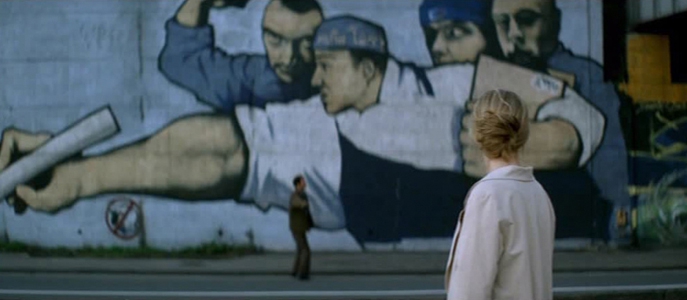The film is based on William Saroyan's novel, The Laughing Matter. The working title – The Scent of Stone – was changed to The Banishment during the course of work, as the creators believed that the latter title more accurately expressed the philosophical concept of the film. After auditions, an actress of the Swedish Royal Theatre "Dramaten", Maria Bonnevie , was cast for the role of Vera. But a difficulty arose: Maria's contract with the theater had her scheduled to rehearse for a new production of August Strindberg's Froken Julie throughout August and September 2005. The first night of the performance had already been announced. "When we began looking for a way to achieve Maria's participation in the filming, I was told that I would have to tackle the subject with the prime minister", recalls producer Dmitry Lesnevsky. According to Swedish law, a performance cannot be cancelled if even one ticket has been sold. Lesnevsky offered to buy out the tickets for all of the premiere performances which called for the participation of Maria Bonnevie. Unfortunately, even though several months remained until opening night, 7 tickets had already been sold. In the end, a solution was found: shooting of the film was postponed for a year in order to wait for Maria. The film lacks any signs that would allow the viewer to identify precisely the time and place of events. Initially, the authors were not even sure what language they would shoot the film in. Eventually, the decision was made to keep the original, Russian text, and even Swedish actress Maria Bonnevie had to learn her part in Russian. When it came time to voice over, the lines of Vera (Maria Bonnevie's character) were read by Elena Lyadova. The search for an actress for dubbing lasted several months, and occurred simultaneously with the editing of the film. More than eighty candidates auditioned. To preclude bias, the director decided that each should anonymously read him the script of two key scenes. He then listened to the recordings and chose several voices for the last stage of the audition. Elena Lyadova was the final choice: in the director’s opinion, her voice ideally matched the character that Maria Bonnevie had created in the role of Vera. Filming took place in several countries: city exteriors were shot in France and Belgium; interior shooting occurred on a set in Russia; and the house, the bridge over a ravine, the church, and also the cemetery were built in Moldova specially for the filming. The construction of the church and cemetery were especially difficult, as they were not supposed to have any obvious attributes of a particular confession. The church and the house on the hill were to look old, a demand that called for meticulous work with textures on the part of the decorators. German specialists were invited to join the team of designers, and, with the help of the newest technology, they managed to create "high-quality mossy stone" and to "age" wood. The total days of shooting for The Banishment numbered 103. The first round took place in autumn 2005. All of the episodes with city exteriors and the passing of cars, along with Vera's walk with Robert along the quay and the episodes outside and inside the morgue, were shot in Belgium and France. This trip occupied two weeks of October 2005. The second round of filming took place 8 months later in June 2006, in Moscow on a set. The second floor of Alex's country house (the children's room; the father's room); the interior of Robert's apartment; the whole interior of Alex and Vera’s city apartment; the interior of Viktor and Lizaveta’s house (the kitchen, the living-room where children piece together the puzzle of the Annunciation, and the children’s room); Mark's hotel room; and even the train car that Alex's family travels in at the very beginning of the film were filmed here. After a short break in the middle of July 2006, necessitated by the transportation of materials and equipment, the group moved to Moldova where the main episodes of the film were shot right up to the beginning of October. To avoid computer-driven methods of color correction and pseudo-anamorphosing, and to print directly from a negative image – in other words, to make a film in 2.35 format – the group rented a camera and anamorphic optics from the English company JDC managed by Joe Dunton, a specialist known in the world of cinema as "the king of anamorphic video". One third of the film spent shooting The Banishment – 20,000 meters of Kodak film – was given by Luigi De Laurentiis in Venice in 2003 as a prize for best directorial debut (The Return). The second third was also the result of an award for the film The Return: The Academy of Cinema Nika presented a certificate for 17,000 metres of Kodak negative film for the best Russian motion picture of 2004. | 